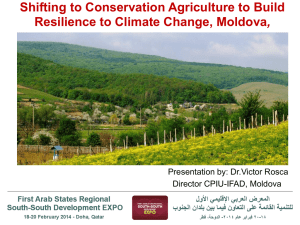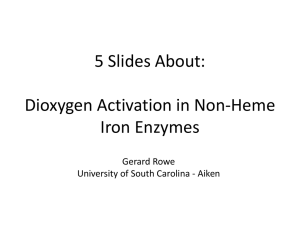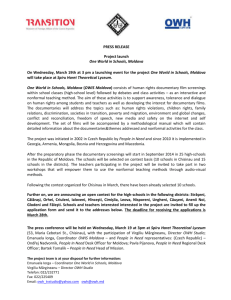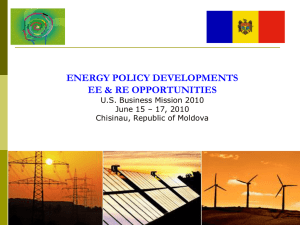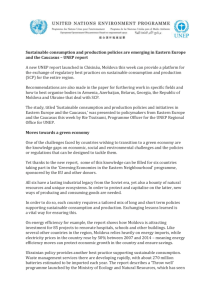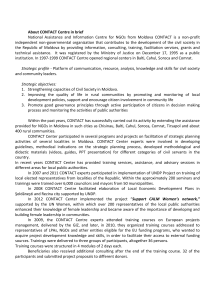LABORATORY OF QUANTUM CHEMISTRY AND CHEMICAL
advertisement
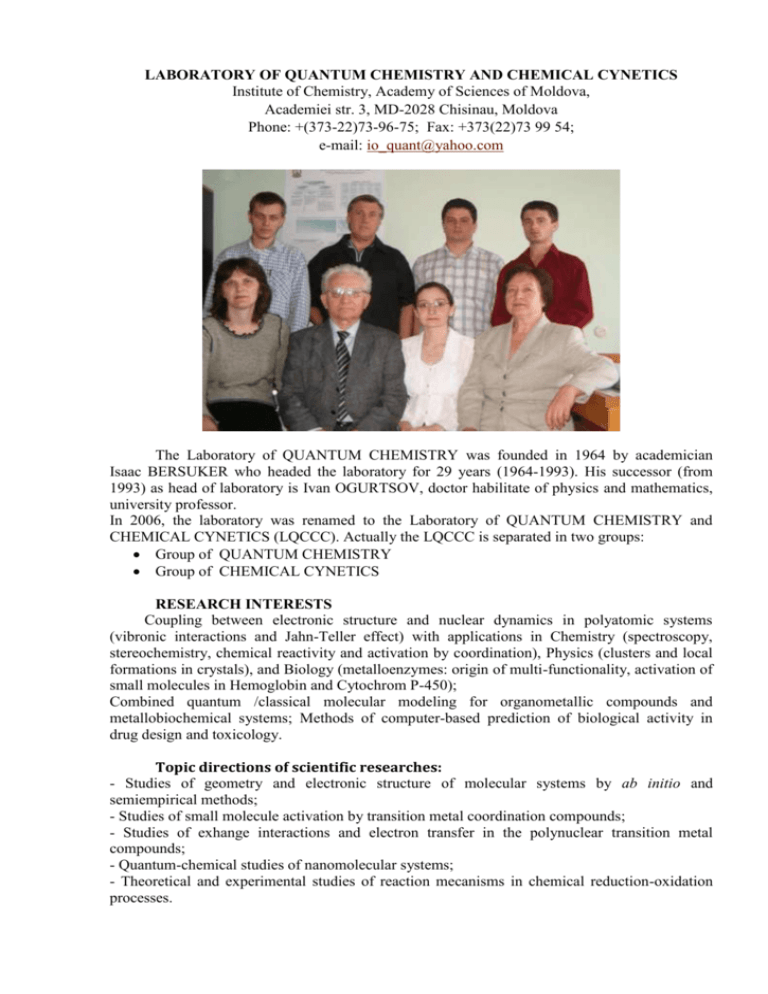
LABORATORY OF QUANTUM CHEMISTRY AND CHEMICAL CYNETICS Institute of Chemistry, Academy of Sciences of Moldova, Academiei str. 3, MD-2028 Chisinau, Moldova Phone: +(373-22)73-96-75; Fax: +373(22)73 99 54; e-mail: io_quant@yahoo.com The Laboratory of QUANTUM CHEMISTRY was founded in 1964 by academician Isaac BERSUKER who headed the laboratory for 29 years (1964-1993). His successor (from 1993) as head of laboratory is Ivan OGURTSOV, doctor habilitate of physics and mathematics, university professor. In 2006, the laboratory was renamed to the Laboratory of QUANTUM CHEMISTRY and CHEMICAL CYNETICS (LQCCC). Actually the LQCCC is separated in two groups: Group of QUANTUM CHEMISTRY Group of CHEMICAL CYNETICS RESEARCH INTERESTS Coupling between electronic structure and nuclear dynamics in polyatomic systems (vibronic interactions and Jahn-Teller effect) with applications in Chemistry (spectroscopy, stereochemistry, chemical reactivity and activation by coordination), Physics (clusters and local formations in crystals), and Biology (metalloenzymes: origin of multi-functionality, activation of small molecules in Hemoglobin and Cytochrom P-450); Combined quantum /classical molecular modeling for organometallic compounds and metallobiochemical systems; Methods of computer-based prediction of biological activity in drug design and toxicology. Topic directions of scientific researches: - Studies of geometry and electronic structure of molecular systems by ab initio and semiempirical methods; - Studies of small molecule activation by transition metal coordination compounds; - Studies of exhange interactions and electron transfer in the polynuclear transition metal compounds; - Quantum-chemical studies of nanomolecular systems; - Theoretical and experimental studies of reaction mecanisms in chemical reduction-oxidation processes. GRANTs Civilian Research and Development Foundation (USA)-Moldovan Research and Development Association (Republic of Moldova): MOC2-3064 „A METHOD OF COMPUTER-AIDED SCREENING AND PREDICTION OF CHEMICAL TOXICITY”, 2006-2007 The main goal of this Project was to reveal the intimate electronic processes that control the activation of dioxygen in its coordination to transition metal systems, a major part of many metabolic chemical reactions with biological, medical, and environmental importance. To implement this goal, ab initio calculations in combination with the vibronic theory of activation were used to investigate a series of coordination systems of transition metals, Ir, Rh, Fe, Co, Mn, and Cu, with a variety of ligands including porphirins, phtallocianine, phenylphosphines, phenantroline, salen, pyridine, and other smaller molecules, with and without coordinated oxygen. A detailed analysis of the geometry and electronic structure of these systems, especially the potential energy as a function of the metal-oxygen interatomic distance in different systems (including the same metal atom with different other ligands at different distances), shows explicitly that the driving force in dioxygen activation is produced by the orbital charge transfers (not the total charge transfers), and explains why some complexes coordinate dioxygen reversibly, while in others this coordination is irreversible, and why the difference between the spin singlet and triplet states of dioxygen is important in these coordination processes. The measure of dioxygen activation is estimated by means of the vibronic activation-theory formulas using the orbital charge transfers derived from ab initio calculations. The results obtained contribute significantly to the general understanding of the processes of dioxygen activation, and can be used directly in design of novel systems with dioxygen storage, transport, and activation. Civilian Research and Development Foundation (USA)-Moldovan Research and Development Association (Republic of Moldova): MC-3009 „DIOXYGEN ACTIVATION BY TRANSITION METAL COORDINATION COMPOUNDS”, 20012003 The main goal of this Project was to reveal the toxicophores – a set of electronic and topologic characteristics that control the toxicity of a series of environmental pollutants, and to work out computerbased methods to predict chemical toxicity. This goal was realized by employing the electronconformational method which includes conformational analysis and electronic structure calculations of the series of toxic compounds, identification of the toxicophore (Tph) by means of multiple comparisons of the electronic structure parameters presented in a matrix form with the toxicities of the most active compounds, and estimation of the influence of toxicophore flexibility and out-of-toxicophore groups on the toxicity quantitatively. This approach was applied to a series of compounds with aquatic toxicity to fish, and to three series of chemicals that have fragrance toxicity. In all these cases the toxicophores were identified and regression models were suggested which predict well the experimental values of toxicity with a reasonable leave-one-out cross-validation. The results obtained can be used in computer-based screening and prediction of chemical toxicity, both qualitatively by revealing the Tph and quantitatively using the obtained regression formulas. These results also contribute significantly to the general understanding of organ toxicity mechanisms. . INTAS – 00-0018 „TOWARDS AN ECOEFFICIENT FUNCTIONALIZATION OF WHITE PHOSPHORUS” , 2001-2004 INTAS – 00-00172 “ POLYMETALLIC CAGES AS MOLECULAR MAGNETS AND CATALYSTS” , 2001-2004 Consiliul Suprem pentru Ştiinţă şi Dezvoltare Tehnologică , Republica Moldova (proiect nr.547) “STUDIUL MECANISMELOR ŞI MODELAREA CATALIZATORILOR NOI A PROCESELOR DE REFORMARE A HIDROCARBURILOR SATURATE” , 2001-2003 SELECTED PUBLICATIONS: 1. Ogurtsov I., Gorinchoy N., Balan I. , VIBRONIC ORIGIN OF THE H3O METASTABILITY , Journal of Molecular Structure, 838 (2007) 107-111 2. Ogurtsov I., Balan I., Munteanu G., „MULTIPOLE MOMENTS and POLARIZABILITY of THE MOLECULAR SYSTEMS WITH D3h SYMMETRY IN ORBITALLY DEGENERATE STATES”, Int. J. Quantum Chem., 106(6) (2006) 1413-1418 3. Ogurtsov I., Mirzac V., “ON THE JAHN-TELLER ORIGIN OF THE PHOSPHORUS MOLECULE P4 ACTIVATION BY THE ONE AND TWO ELECTRON REDUCTION”, Adv. Quantum Chem., 44 (2003) 401–412 4. Ogurtsov I.Ya., Munteanu G., Bantush L., Bersuker I.B., PSEUDO JAHN-TELLER ORIGIN OF FORMALDEHYDE MOLECULAR GEOMETRY IN EXCITED STATES, J. Mol. Chem. (THEOCHEM), 541(2001)141-148. 5. Ogurtsov I.Ya., Mirzac V., Bersuker I.B. “COMPARATIVE ANALYSES OF THE DIOXYGEN ADITION TO [M(salen)(py)n] (M=Co,Mn; n=0,1)” .Proceedings of the 28th Congress of American – Romanian Academy of Sciences and Arts, June 3 – 9, 2003, Targu - Jiu, Romania, pp.979 - 982 6. Ogurtsov I.Ya., Gorincioi N., Baciu L., Bersuker I. B. “AB INITIO CALCULATION OF DIOXYGEN MOLECULE ACTIVATION BY ORGANOMETALLIC COMPLEX [Rh(CO)Cl(PPh3)2]”, Proceedings of the 28th Congress of American – Romanian Academy of Sciences and Arts, June 3 – 9, 2003, Targu - Jiu, Romania, pp. 987 - 990 7. Ogurtsov I.Ya., Gorinchoy N., Turta C.I., Bersuker I. B., Baciu L. “INTERACTION OF THE Mn(pc) COMPLEX WITH DIOXYGEN. AB INITIO STUDY “. Annals of Vest University of Timisoara (Romania), 2003, pp. 987 - 990 8. Ogurtsov I.Ya., Gorincioi N., Baciu L., Bersuker I. B. “COMPARATIVE QUANTUM CHEMICAL STUDY OF DIOXYGEN ACTIVATION BY ORGANOMETALLIC COMPLEXES [Ir(CO)L(PPh3)2](L=Cl,I)” , Annals of Vest University of Timisoara (Romania), 12(3)(2003) 1227- 1232 9. Ogurţov I., N. Gorincioi, I. Balan,G. Munteanu ”THE D2h VERSUS D2d NUCLEAR SIMMETRY COMPETITION IN THE CnH4 MOLECULES. PSEUDO JAHN-TELLER APPROACH”, Annals of Vest University of Timisoara (Romania), 12(3)(2003) 12331242 10. Bersuker I.B., Ogurtsov I.Ya., „THE JAHN-TELLER EFFECT IN DIPOLE (MULTIPOLE) MOMENTS AND POLARIZABILITIES OF MOLECULES”. Adv. Quantum Chemistry, 18 (1986) 1-84 11. Ogurtsov I., V. Mirzac, “STUDIUL CUANTO-CHIMIC AL SISTEMELOR PLANARE PNQ (N=3-6, Q=0, ±1, -2)”, Anal. Universităţii de Stat din Moldova, Seria ”Şt. Chimbiol.”, 2003, p.379-385. 12. Ogurtsov I., Peruzzini M., Mirzac V., “ACTIVAREA P4 PRIN OXIDARE ŞI REDUCERE. ASPECTE CUANTO-CHIMICE”, Anal. Universităţii de Stat din Moldova, Seria ”Şt. Chim-biol.”, 2002, p.370-374 13. Ogurţov I., Balan I., Munteanu G.,” STRUCTURA ELECTRONICĂ ŞI MOMENTELE DIPOL ALE MOLECULELOR VF3 ŞI MnF3”, Anal. Universităţii de Stat din Moldova, Seria ”Şt. Chim-biol.”, 2002, p.375-376 14. Ogurţov I., V. Mîrzac, „STUDIUL CUANTO-CHIMIC COMPARATIV AL ACTIVĂRII FOSFORULUI ALB ÎN SISTEMELE [MLP4] Q (M= NI, CU; L= bipy, phen; q= 0, 1, 2)”, Anale Stiintifice ale Universitatii de Stat din Moldova (seria “Stiinte chimico-biologice”), 2004, p. 473 15. Огурцов И.Я., Кухарук А.С., “О ПРИМЕНИМОСТИ МЕТОДА КВАЗИСТАЦИОНАРНЫХ КОНЦЕНТРАЦИЙ НА ПРИМЕРЕ ПРОСТЕЙШЕЙ КАТАЛИТИЧЕСКОЙ СИСТЕМЫ”, Anal. Universităţii de Stat din Moldova, Seria ”Şt. Chim-biol.”, 2004, p.386-391 16. И. Огурцов, В. Енаки, А. КУхарук, „КОМПЬЮТЕРНОЕ МОДЕЛИРОВАНИЕ КИНЕТИКИ КАТАЛИТИЧЕСКОГО РАЗЛОЖЕНИЯ ПЕРОКСИДА ВОДОРОДА ПОЛИЯДЕРНЫМИ КАРБОКСИЛАНТЫМИ КОМПЛЕКСАМИ КОБАЛЬТА И ЖЕЛЕЗА”, Anale Stiintifice ale Univers. de Stat din Moldova (seria “Stiinte chimico-biologice”),2004, 478 17. Ogurţov I. Ya., Baciu L., „ACTIVAREA OXIGENULUI DE CĂTRE COMPUSUL [Mn(phen)2(H2O)2]2+“, Anale Stiintifice ale Universitatii de Stat din Moldova (seria “Stiinte chimico-biologice”), 2004 p. 469 18. Ogurţov I., N. Gorincioi, I. Balan,G. Munteanu ” COMPARATIVE AB INITIO STUDY OF THE PSEUDO JAHN-TELLER INSTABILITY OF PLANAR D3h CONFIGURATION OF H3O RADICAL AND H3O+ CATION” Anal. Universităţii de Stat din Moldova, Seria ”Şt. Chim-biol.”, 2003, p.366-371 19. Ogurtsov I.Ya., Mirzac V.. “STATE OF OXYGEN IN [Co(salen)(py)O2] SYSTEM. QUANTUM – CHEMICAL STUDIES”. Annals of State University of Moldova. Series “Chemical – Biological Sciences”, Chişinău, (2003)372 - 378 20. Ogurţov I., Gorincioi N., Baciu L., Balan I. “MODELAREA MECANISMELOR DE DEHIDROGENARE A CICLOHEXANULUI PE SUPRAFAŢA CATALIZATORILOR η - Al2O3 – M ( M = Ti, Cr, Mn )”, Anal. Universităţii de Stat din Moldova, Seria ”Şt. Chim-biol.”, 2003, p.360-365 GROUP MEMBERS Head of the Laboratory – Ogurtsov Ivan, Doctor Habilitate of Chemistry, University Professor, 1. Gorinchoi Natalia, Senior Scientist, Doctor of Chemistry 2. Gorbachiov Mihail,. Senior Scientist, Doctor of Chemistry 3. Dobrova Bella, Researcher, Doctor of Chemistry 4. Tihonovschi Andrei, Researcher 5. Balan Iolanta, Researcher 6. Boldyrev Serghei, Senior Scientist, Doctor of Chemistry 7. Arsene Ion, PhD. Student; 8. Cantsir Eugen, PhD. Student; 9. Secara Natalia, PhD. Student
